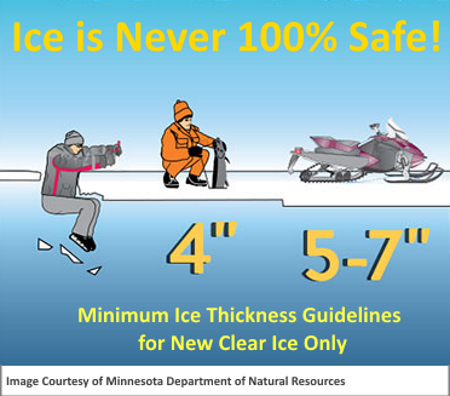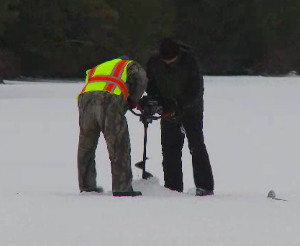Ice Safety

How Can You Tell if Ice Is Safe?
Ice is never 100 percent safe. You cannot judge the strength of ice just by its appearance, age, thickness, or the temperature. Other factors, including water depth, size of the water body, water chemistry, currents, and local weather conditions, all impact ice strength.
Did You Know?
New ice is usually stronger than old ice. Four inches of clear, newly-formed ice may support one person, while a foot or more of old, partially-thawed ice may not.
Ice seldom freezes uniformly. It may be a foot thick in one location and only an inch or two just a few feet away. Continue to check the conditions as you move around on the ice.
Ice formed over flowing water and currents is often dangerous. This is especially true near streams, bridges, and culverts. Also, the ice on outside river bends, and inlets and outlets of lakes and ponds is usually weaker due to the undermining effects of the faster current.
The insulating effect of snow slows down the freezing process. The extra weight also reduces how much weight the ice sheet can support. Also, ice near shore can be weaker than ice that is farther out.
Booming and cracking ice isn't necessarily dangerous. It only means that the ice is expanding and contracting as the temperature changes.
General Ice Thickness Guidelines
These guidelines are for new, clear (blue) ice on lakes and ponds. White ice or "snow ice" is only about half as strong as new clear ice.

Ice Thickness (in inches)
Under 4" - STAY OFF
4" -- Ice fishing or other activities on foot
5" - 7" -- Snowmobile or ATV
Note: It is illegal to drive a car or truck on the ice in Connecticut.

Checking Ice Thickness
Ice thickness can vary over a single body of water; it may be a foot thick in one location and only an inch or two a few feet away.
Use an ice chisel, auger, or cordless drill to make a hole in the ice. Bring a tape measure to measure the thickness of the ice at regular intervals.
Do not judge ice thickness by how easily a chisel or drill breaks the surface. It happens so quickly that it is easy to overestimate the thickness.
Before Heading Out
Check the thermometer, not the calendar. Air temperatures and recent weather patterns can impact ice quality. Just because the ice was safe on a certain date last year does not mean it will be safe this year.
Tell someone your plans. Let them know where you are going and when you expect to be back.
Carry a cell phone in case of emergency.
Wear a life jacket or float coat. If you fall in, it will help keep your head above water and provide some insulation against the effects of cold water.
Bring an ice safety kit: Rope, ice picks, whistle, and spiked shoes/creepers. Know how to use the ice picks to rescue yourself and the rope to rescue others.
What if You Fall In?
- Do not panic. Call for help if there are people nearby.
- Do not remove winter clothing. Trapped air can help provide warmth and flotation. This is especially true with a snowmobile suit.
- Turn toward the direction you came. That is where you will probably find the strongest ice.
- Place your hands and arms on the unbroken surface. If you have a pair of nails, sharpened screwdrivers, or ice picks, use them to pull yourself up onto the ice.
- Kick your legs and work your way back onto the solid ice. Kick your feet and dig in your ice picks to work your way back onto the solid ice. If your clothes have trapped a lot of water, you may have to lift yourself partially out of the water on your elbows to let the water drain before starting forward.
- Lie flat and roll away. Once back on the ice, roll away from the hole. This distributes your weight and may help prevent you from breaking through again.
- Get to a warm, dry, sheltered area and re-warm yourself immediately. Change out of wet clothing into something dry. In you are in a remote area, get to or start a campfire. Otherwise, get to a car or house. Seek medical advice from your physician.
What if Someone Else Falls In?
First, call 911 for help if you or someone nearby has a phone.
Resist the urge to run up to the edge of the hole. This would most likely result in two victims in the water.
Preach, Reach, Throw, Go
- Preach - Shout to the victim to reassure them that help is on the way.
- Reach - If you can safely reach the victim from shore, extend an object such as a rope, tree branch, jumper cables, or ladder to them. If the person starts to pull you in, release your grip on the object and start over.
- Throw - From shore, toss one end of a rope or something that will float to the victim. Have them tie the rope around themselves before they are too weakened by the cold to grasp it.
- Go - If the situation is too dangerous for you to perform a rescue, do not go out onto the ice. Call 911 for help. Untrained rescuers can become victims themselves.
Ice Fishing | Skiing/Skating/Snowmobiling | Outdoor Recreation
Content Reviewed January 2022

